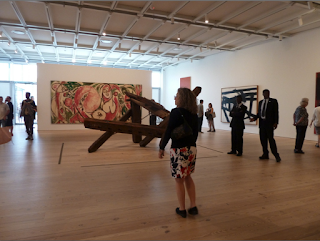 |
| The Whitney Museum. |
The last few weeks have really been a bi-continental "tour de culture" for your humble blogger and her DH, as we visited libraries and museums in London and New York. This month we investigated the new Whitney museum, eight stories of art in southern Manhattan, overlooking the Hudson River. That the museum happens to provide a southern terminus for the High Line enriches both destinations.
New York Times critic Roberta Smith's
review of the museum is more or less spot-on.
An assemblage of volumes - rectangular and trapezoidal shapes of glass and steel are mounded together - the new museum show-cased its own 22,000-strong collection in the inaugural exhibit featuring 600 works, entitled "
America is Hard to See." The exhibit ran from May 1, 2015 to September 27, 2015. The event title is from a Robert Frost poem in which the poet, somewhat sardonically, reflects on Columbus' figurative blindness in his inability to grasp that, while he didn't sail to the East Indies as planned, he discovered something monumental- exactly what, well, we're still discovering that ourselves, aren't we?
 |
| A nice place to chill. |
At the ground floor, the museum "lifts its skirts," revealing a transparent glass wall in an open invitation to "come on in." The bushy bits of foliage growing in stairway planting pockets are oddly, but pleasantly, residential in scale, and the chartreuse lawn chairs scattered around add to the front porch vibe.
 |
| Gift shop. |
We had ordered tickets online, so cruised past the gift shop, and the ticket line, and climbed the stairs.
 |
| Ticket desk. |
 |
| Stairwell with light sculpture by Felix Gonzales-Torres. |
The Whitney eschews the traditions of monumental stairs or central atrium, and the vertical pedestrian circulation can feel a bit squirrel-y for such a large building. On the other hand, one remembers the now-defunct American Folk Art Museum, a tiny museum whose monumental stair ate up space which should have been given to exhibit space. In addition, the Whitney's wonderful outdoor decks and stairs more than compensate for the utilitarian, fire-code-compliant interior stairs.
 |
| Looking south. |
The four outdoor terraces are splendid, and provide the best way to move between the upper
floors, at least in fair weather.
 |
| Outdoor terrace and stairs. |
 |
| Another outdoor terrace. |
 |
| Ruth Asawa sculpture should hang here permanently. |
But what about the art? Well, when I said to DH, there's so much more art by women than the Whitney ever showed before, his response was "What, more than zero?" The work on display was incredibly diverse, in terms of historic period, style, and medium, as well as in those categories enumerated by the census, gender and race. Let's hope future programming continues to be this inclusive, allowing patrons to make new discoveries as well as revisit canonical works.
Some works were old friends, such as
Calder's Circus, seen below. The gift shop has a DVD of Calder animating his figures made of wire and scraps of cloth and detritus such as bottle caps, or check out this
youtube video.
 |
| Calder's Circus, Alexander Calder, 1926-1931. |
 |
| Calder's Circus, detail. |
 |
| Gallery. |
In addition to becoming reacquainted with
Calder's Circus, it was rewarding to see Lee Krasner's gestural "The Seasons," on the far wall, finally gets its due in a worthy, appropriately-sized setting. If you like to look at people looking at art, this is the place, as the generously-sized galleries make unobtrusive observation possible. There is also a surprising amount of natural light, so the new museum avoids that entombed feeling which was a hallmark of the old Marcel Breuer building.
 |
| Looking at art. |
 |
| The ubiquitous phone camera meets Chuck Close's Philip Glass. |
|
 |
| Wayne Thibeaud's Pie Counter has its picture taken. |
In the spirit of discovery, we met work by now-favorite artist
Alma Thomas for the first time. Here's hoping for a retrospective.
 |
| Mars Dust, Alma Thomas, 1972. |
Some nuts and bolts: the admission price to the Whitney is steep - $22. However, each Friday the museum closes at 10 pm and has a pay-as-you-wish policy from 7 pm to 9:30 pm. Be forewarned, the line for this low-cost admission began at 6 pm and had snaked down the block by 7 pm. In addition, there is a gallery on the first floor, celebrating founder Gertrude Whitney, that one can enter without paid admission, at least at the time of our visit.
 |
| Gertrude Vanderbilt Whitney, Robert Henri, 1916. |
The day of our trip to the Whitney happened to be September 11, and we walked along the river towards the
Tribute in Light, beams of illumination rising up from the former World Trade Center site.
 |
| Tribute in Light, September 11, 2015. |
Closing our day, the Tribute in Light from our hotel window.


















